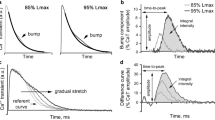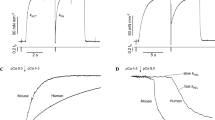Abstract
Objective: In congestive heart failure both a decreased function of the sarcoplasmic Ca2+-ATPase and a negative force-frequency relationship have been shown. This study aimed to investigate a possible relationship between frequency potentiation, sarcoplasmic Ca2+-ATPase activity, and SERCA2 protein expression in human myocardium.
Methods: Frequency potentiation was studied in electrically stimulated, isometric, left ventricular papillary muscle strip preparations (37°C, 0.5–3.0 Hz) from terminally failing (NYHA IV; n=5, dilated cardiomyopathy) and nonfailing (donor hearts, n=5) human myocardium. In the identical samples the Ca2+-ATPase activity (NADH coupled assay) and the protein expression of sarcoplasmic Ca2+-ATPase (SERCA2), phospholamban, and calsequestrin (western blot) were determined. The frequency dependent change in the force of contraction and Vmax of the Ca2+-ATPase activity and the protein expression of SERCA2 were correlated with each other.
Results: In terminally failing myocardium the force-frequency relationship was negative (2.0 Hz vs. 0.5 Hz: –0.2±0.1 ΔmN) contrasting a positive rate dependent potentiation of force in nonfailing tissue (2.0 Hz vs. 0.5 Hz: +0.8±0.2 ΔmN; p<0.01). In failing myocardium the corresponding maximal sarcoplasmic Ca2+-ATPase activity (Vmax) was reduced significantly compared to nonfailing myocardium (174±24 vs. 296±31 nmol ATP/mg·min, p<0.01). The protein expression of SERCA2, phospholamban, and calsequestrin remained unchanged in failing myocardium. The maximal Ca2+-ATPase activity significantly correlated with the frequency dependent change in force of contraction (2 Hz vs. 0.5 Hz: r=0.88, p=0.001; 3 Hz vs. 0.5 Hz: r=0.84, p=0.004). No correlation between protein expression of SERCA2 and Ca2+-ATPase activity or change in force of contraction was observed.
Conclusion: Due to a significant correlation between sarcoplasmic Ca2+-ATPase activity and frequency potentiation, the negative rate dependent force potentiation in human heart failure could be at least in part be attributed to decreased function of the sarcoplasmic Ca2+-ATPase.
Similar content being viewed by others
Author information
Authors and Affiliations
Additional information
Received: 8 January 1998, Accepted: 2 June 1998
Rights and permissions
About this article
Cite this article
Frank, K., Bölck, B., Bavendiek, U. et al. Frequency dependent force generation correlates with sarcoplasmic calcium ATPase activity in human myocardium. Basic Res Cardiol 93, 405–411 (1998). https://doi.org/10.1007/s003950050109
Issue Date:
DOI: https://doi.org/10.1007/s003950050109




